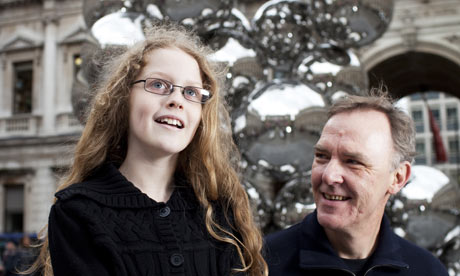
Life, death and concrete spaghetti … Isabella Welch, winner of this years Guardian young art critic award, with Adrian Searle. Photograph: David Levene
Last month I took a trip to the Royal Academy in London with Adrian Searle, to catch the Anish Kapoor show in its final days. Outside the gallery, giant metal balls were piled high on top of each other, taking over the courtyard. I stood and looked at Kapoor's sculpture, at the way it reflected back lots and lots of little Royal Academies, making the gallery look bigger than it was. The balls reflected each other, too, so they looked as if they had bubbles inside them. Together, the bubbles were like running water, trickling down to the ground.
Inside the gallery, the first thing we saw was a variety of brightly coloured, powdery sculptures, coloured red, yellow and pitch-black, protruding through the walls and the floor. Spiky, smooth, wavy or curved, the sculptures took on very different shapes when looked at from different angles. The colours were simple, but as bright as colours can possibly be. Adrian said they were so pretty you wanted to reach out and touch them. At that moment, a gallery worker with a feather-duster in her hand gave us a glare of very strong disapproval.
In the same room, there was a convex protrusion from the wall. It was painted the exact same colour as the wallpaper, so I had no idea it was there until I looked at it from a different angle. Even harder to focus on were the mirrors in the next room. These were convex and concave mirrored sculptures that had the effect of making you look either very thin or very magnified. One even made you seem to disappear, if you got right up close to it. Like many of Kapoor's works, it was so large it made me feel very small and unimportant.
I was lucky enough to bump into Kapoor himself, and I asked him about his work. He said he was interested in "process". For instance, the movement of the big red wax block we were standing in front of was incredibly slow. It had been forced through the gallery's arched doorways on a track so many times that it was now the exact shape of the arches. Its dark-red mass was like something that had just been splodged out of a tin.
In another room, there was a cannon that fired paint-tin-sized pellets of wax through an arch into a small room in the corner. This was very fast and very loud. It left behind smashed bits of blood-red wax, deep enough to wade through – though I don't recommend anybody try it.
Standing in the next room, in the middle of what looked like piles of concrete spaghetti, I began to feel overpowered. The sculptures were all around me, surrounding me, making me think of living creatures and their living bodies. I had a slight feeling of dread. What with the blood-like floor and the heaps of ash-coloured concrete intestines, these works were forcing me to think about bodies and new life, and even death.
The idea of birth creeps me out. I think it might be the same for Anish Kapoor. The shapes of many of the mirrored sculptures were wonderful. But I preferred the ones that made me feel a bit scared. Feeling unsettled can be beautiful, too.
http://www.guardian.co.uk/artanddesign/2010/jan/20/young-critic-anish-kapoor-review

